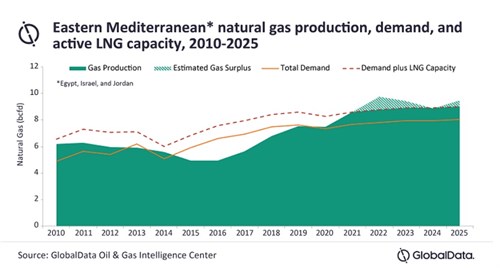COVID-19 could force constrained Eastern Mediterranean gas production until 2023
Eastern Mediterranean regional gas demand has been suppressed and LNG spot prices have been crippled by the impacts of COVID-19 in the first half of 2020. The longer lasting impacts are likely to weaken the demand outlook, which could force reduced gas output from the region until 2023, according to GlobalData.
Daniel Rogers, Oil and Gas Analyst at GlobalData, comments: “Major gas fields including Zohr and Tamar have constrained production in light of diminished domestic demand and an unfavorable LNG market.”
Weak demand and spot prices have curbed LNG exports out of Egypt throughout April, May, and June this year. In addition, the reduced regional demand has constrained gas output and instigated downward revisions of Israel’s forecast gas sales volumes.

Rogers continues: “The 2020 downturn combined with the wider economic impact of COVID-19 have significantly reduced the regional demand growth outlook. With Zohr and Leviathan potentially ramping up to capacity and additional volumes coming from Karish, we could see the region’s gas surplus exceeding export capacity for a number of years. This would mean continued production constraints, likely on the major producing fields, though this could be mitigated if partners can agree to re-start the Damietta LNG plant.
“In the short term, the key gas producers in the region – the likes of BP, Eni, Shell, and Delek are facing weakened LNG spot prices and gas production curtailments. While over the longer term, the lack of active LNG export capacity and muted domestic consumption could prove problematic for recent entrant Chevron and Israeli focused Energean.”

- ExxonMobil halts 1-Bft3d blue hydrogen project in Texas
- Aramco and Yokogawa commission multiple autonomous control AI agents at Fadhili gas plant
- Ukraine will resume gas imports via Transbalkan route in November
- Mitsubishi to inject $260 MM into Brunei LNG project
- Freeport LNG (U.S.) on track to take in more natgas on Thursday after unit outage



Comments